Mining Museum description and photos - Russia - St. Petersburg: St. Petersburg
Rating: 8,9/10 (3543 votes) 
Mining Museum description and photos - Russia - Saint Petersburg: Saint Petersburg. Detailed information about the attraction. Description, photos and a map showing the nearest significant objects. Photo and descriptionBy the decree of Empress Catherine II in 1773, the Mining Museum was created at the same time as the Mining School. Initially, three offices were combined: Metallic, Mining and Mineral. A few years later, the museum was visited not only by teachers and students, but, as they said at that time, “curious visitors.” Currently, the museum is located in the main building of the Mining Institute and occupies twenty halls with a total exposition area of 2800 sq. .m. The first section of the museum is devoted to geology and mineralogy; it also includes petrography, minerals and paleontology. The second section is devoted to the history of the development of mining technology and methods of mining. The third section is entirely devoted to the Mining Institute. The museum contains samples (about 230,000) from many countries, located on all continents, including Antarctica. Acquaintance with the museum begins with acquaintance with the building of the Mining Institute, which was built at the beginning of the nineteenth century by the famous architect A.N. Voronikhin. The building is decorated with sculptures by the famous sculptor V.I. Demut-Malinovsky (Abduction of Proserpine by Pluto) and the equally famous sculptor S.S. Pimenova (The struggle of Hercules with Antaeus). A tour of the departments of the Mining Museum tells visitors about how the Mining Museum and Institute was created, gives an idea of how and in what conditions, minerals are formed, how life developed on our planet, about what ores, rocks are part of the earth's crust. How, when, where and under what conditions exogenous and endogenous processes occur and what is it in general. Much attention in the museum's expositions is devoted to the history of mining technology and methods of industrial mining. The museum expositions began with those ore and mineral samples that were sent to the institute by ore and mining enterprises. The rich collection of meteorites usually arouses great attention and genuine interest among visitors. It contains nearly three hundred samples. One of them has a very interesting history and a big name. It is called "Borodino". This meteorite fell to the ground in the night of 1812 on the eve of the historic battle, which is why it got its name. In 1890, it was presented to the museum by Herr Gerke, who was the heir to the one who saw his fall and then found the sentry. Among the exhibits of the museum is the world's largest solid block of malachite. It was mined at the world-famous (thanks to the tales of Pavel Petrovich Bazhov) Gumeshevsky deposit in the Ural Mountains. Its weight is 1504 kg, it was donated to the museum by Empress Catherine II. Russian tsars have repeatedly presented the museum with rarities. It is worth noting the largest copper nugget, which resembled a bearskin in its outlines and got its name from this. The nugget was mined in Kazakhstan and weighs 842 kg. It was donated to the museum by Alexander II. The museum's exposition contains many models showing and telling about how mining and processing of minerals was carried out and how it is now being carried out. In a specially equipped storehouse of the museum, precious metals in nuggets and twenty products of K. Faberge himself are stored. An indescribable impression on visitors is made by an almost four-meter metal palm tree created by the famous Donbass master - blacksmith A.I. Mertsalov and his assistant F.F. Shkarin from a whole piece of rail. This palm tree won the Grand Prix at an industrial exhibition in 1900 in Paris. The Zlatoust arms factory surprises everyone with its coat of arms of the Russian Empire, made of forks and knives in the shape of a two-headed eagle. No one is left indifferent by the images on the so-called landscape stones: jasper, calcite, agate, rhodonite, aragonite. On them you can see the seashore, a beautiful girl, and a winter fairy tale.           We also recommend reading Cathedral Church of St Thomas description and photos - UK: Portsmouth Topic: Mining Museum description and photos - Russia - St. Petersburg: St. Petersburg. |




